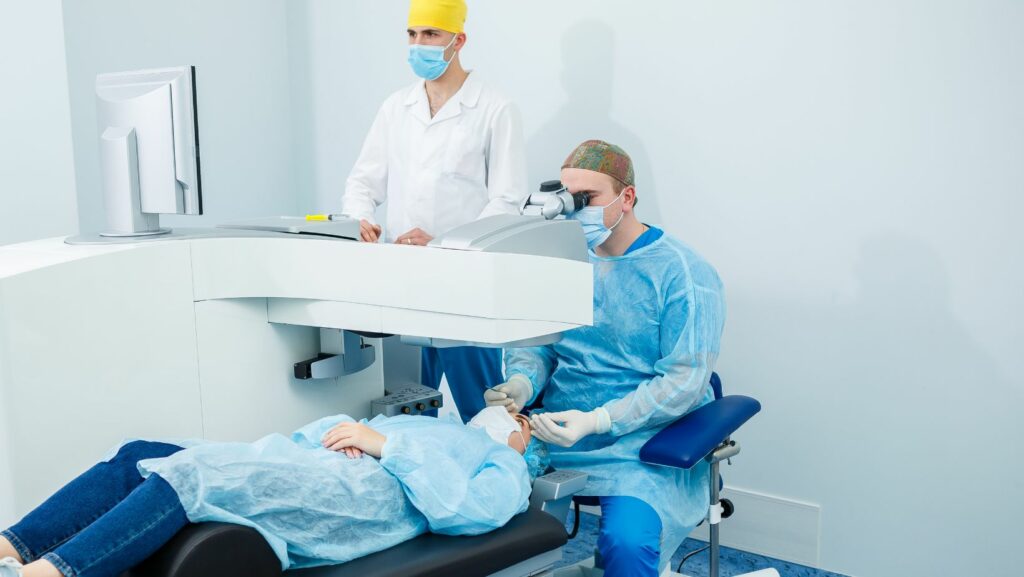![]()
![]() Laser Treatment for Glaucoma
Laser Treatment for Glaucoma
Glaucoma refers to a group of eye conditions damaging the optic nerve, crucial for vision. This damage often results from abnormally high pressure in the eye. Glaucoma is a leading cause of blindness, especially in older adults, though it can occur at any age. There are several types of glaucoma, with open-angle and angle-closure being the most common.
Open-Angle Glaucoma: The most prevalent form, accounting for about 90% of glaucoma cases. It develops gradually as the eye’s drainage canals become clogged over time, leading to increased eye pressure.
Angle-Closure Glaucoma: Less common and often acute, it’s characterized by a rapid rise in eye pressure due to a blocked drainage angle. This type needs immediate medical attention to prevent vision loss.
Risk factors for glaucoma include age, family history, medical conditions like diabetes or hypertension, and certain anatomical features of the eye. Regular screenings are essential because early detection can prevent irreversible damage. Identifying the type and extent of glaucoma guides effective treatment, including medication, surgery, or laser therapy.
Laser treatment for glaucoma offers a promising solution for managing intraocular pressure by improving fluid drainage in the eye. It’s less invasive compared to traditional surgery, making it an appealing option for many patients.
Types of Laser Treatments
- Selective Laser Trabeculoplasty (SLT): SLT targets the trabecular meshwork, increasing fluid outflow and reducing pressure. Studies showcase its efficacy in both open-angle glaucoma and ocular hypertension.
- Argon Laser Trabeculoplasty (ALT): ALT similar to SLT but uses a different type of laser energy, primarily for open-angle glaucoma, enhancing the trabecular meshwork’s drainage capabilities.
- Laser Peripheral Iridotomy (LPI): LPI creates a small hole in the iris, beneficial for angle-closure glaucoma by easing fluid access to the drainage pathway.
- Cyclophotocoagulation: This method targets the ciliary body to lower aqueous humor production, effective for advanced or refractory cases of glaucoma.
Laser treatment typically occurs in an ophthalmologist’s office and involves using specialized laser equipment. Patients receive eye drops to numb the eye, ensuring comfort throughout the procedure. The laser focuses on specific eye structures, like the trabecular meshwork or iris, to enhance drainage or reduce fluid production. The entire session usually lasts 10-15 minutes, and patients can often resume normal activities shortly afterward. Post-procedure, doctors monitor intraocular pressure, and patients may require follow-up treatments to maintain optimal pressure levels.
![]() Benefits of Laser Treatment
Benefits of Laser Treatment
Laser treatment for glaucoma offers several advantages, making it an appealing option for managing this eye condition. It effectively reduces intraocular pressure with fewer complications compared to traditional methods. Studies show that laser treatment maintains intraocular pressure reduction over time.  For open-angle glaucoma, procedures like Selective Laser Trabeculoplasty (SLT) often have results that last several years. Repeat procedures may extend the benefits, providing sustained pressure control. Additionally, patients may experience reduced reliance on medications, given the effectiveness of laser treatments.
For open-angle glaucoma, procedures like Selective Laser Trabeculoplasty (SLT) often have results that last several years. Repeat procedures may extend the benefits, providing sustained pressure control. Additionally, patients may experience reduced reliance on medications, given the effectiveness of laser treatments.
Laser procedures are less invasive than conventional surgeries. They typically require no incisions, which minimizes risk and post-operative recovery time. Laser treatments like Argon Laser Trabeculoplasty (ALT) involve quick, outpatient procedures performed in an ophthalmologist’s office. Patients generally return to normal activities on the same day due to the minimal disruption caused by the procedure. This approach, while less invasive, still provides substantial relief from the symptoms of glaucoma.
![]() Potential Risks and Side Effects
Potential Risks and Side Effects
Laser treatment for glaucoma, while effective for many, carries certain risks and potential side effects. Patients might experience inflammation following the procedure. Corticosteroid eye drops often manage this symptom effectively.
Intraocular pressure might increase temporarily after treatment. Monitoring by an ophthalmologist helps manage this risk. Rarely, the procedure may lead to damage in the surrounding eye tissue. Such complications highlight the importance of selecting an experienced specialist.
There’s a possibility that the treatment’s effects diminish over time. Patients might require additional interventions if intraocular pressure rises again. While most recover quickly, some experience prolonged discomfort or vision changes. Reporting these symptoms to healthcare providers is crucial for timely management.

